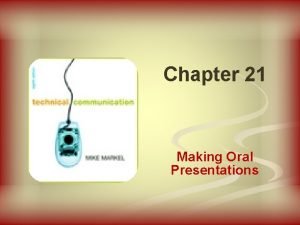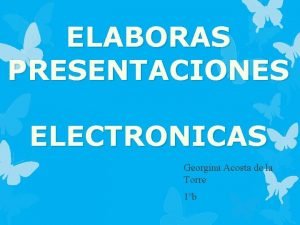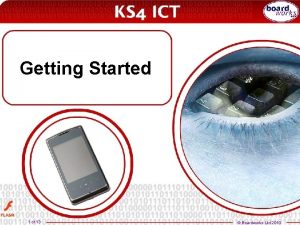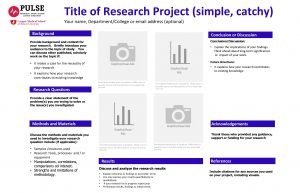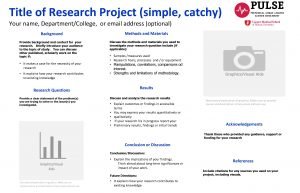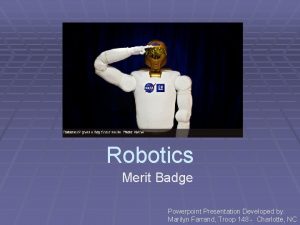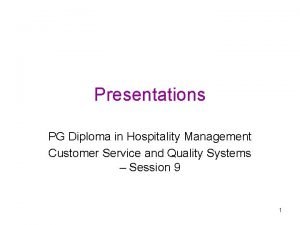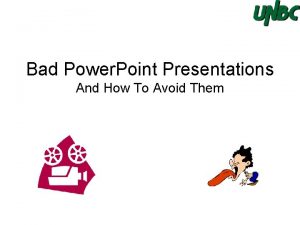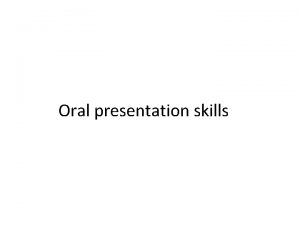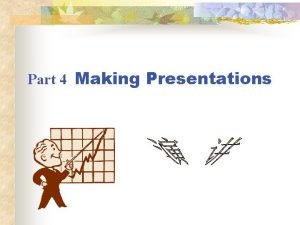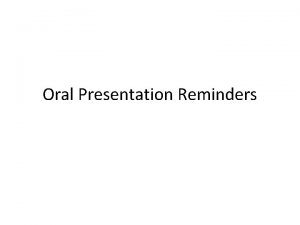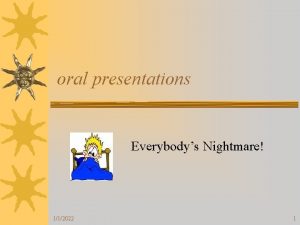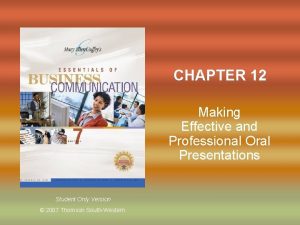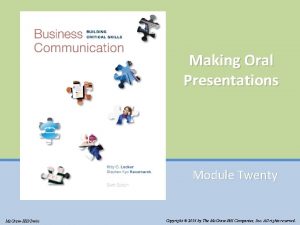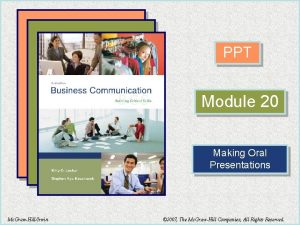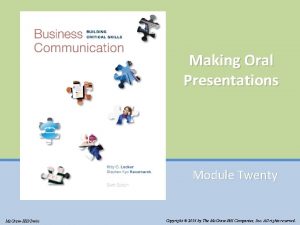Chapter 11 Making Oral Presentations Making oral presentations



























- Slides: 27

Chapter 11 Making Oral Presentations

Making oral presentations • • Plan and organize a presentation. Plan a team and video presentation. Develop effective visual aids. Practice and deliver a presentation. Copyright © Houghton Mifflin Company. All rights reserved. 11 | 2

Purposes of a report Motivating Reporting Purpose Persuading Copyright © Houghton Mifflin Company. All rights reserved. Explaining 11 | 3

How formal? • • • The stakes Audience size Audience opposition Need for repeat performances Complexity Cultural expectations of audience Copyright © Houghton Mifflin Company. All rights reserved. 11 | 4

Use an outline—not a script Absenteeism Rate—Slide 1 • 4. 7% first 6 mo • • 5% higher than last yr 14% increase in 3 yrs • Industry average = 3. 6% (steady) Copyright © Houghton Mifflin Company. All rights reserved. 11 | 5

What do you want to accomplish? • Reporting: Telling what happened at the OSHA meeting last week • Explaining: Showing how to complete the new expense report forms • Persuading: Convincing the executive committee to adopt a tuition-reimbursement plan • Motivating: Inspiring the employees to volunteer to become a Big Brother or Big Sister Copyright © Houghton Mifflin Company. All rights reserved. 11 | 6

Why does an audience get distracted? • Speaker believes common knowledge is adequate background • Speaker does not make the structure of the presentation clear • Speaker does not use visual aids adequately • Speaker uses long, complicated sentences and unnecessary jargon, abbreviations, or difficult words • Speaker reads too fast and without pacing Source: Adapted from: http: //www. efcats. org/pages/presentation/oralpresentation. html, accessed 10/1/07. Copyright © Houghton Mifflin Company. All rights reserved. 11 | 7

The opening • • • Quote a well-known person Ask a question Present a hypothetical situation Relate an appropriate story Give a startling fact Use a dramatic prop or visual aid Copyright © Houghton Mifflin Company. All rights reserved. 11 | 8

Don’t lose time at the start • Do not repeat the title, explain who you are, or repeat your affiliation, especially if the material is printed or has been verbalized. • Plan the opening carefully. Spontaneous statements often fall short of the desired effect. • Write the first five minutes in short, powerful, crystal clear sentences, and rehearse several times. Source: Adapted from: http: //www. efcats. org/pages/presentation/oralpresentation. html , accessed 10/1/07. Copyright © Houghton Mifflin Company. All rights reserved. 11 | 9

Choose a logical sequence • • Criteria Direct sequence Indirect sequence Chronology Cause/effect/solution Order of importance Elimination of alternatives Copyright © Houghton Mifflin Company. All rights reserved. 11 | 10

Work-team presentations • • Assignment of roles Leader responsibilities Unity and coherence Introductions and transitions • Non-speaker roles Copyright © Houghton Mifflin Company. All rights reserved. 11 | 11

Using the Internet Access: http: //www. mindtools. com/pages/article/new. LDR_83. htm • Scroll down to “Understanding Belbin's Team Roles Model” • Identify the nine team-roles presented in three categories: • Action-oriented • People-oriented • Thought-oriented Which role do you typically fill? Copyright © Houghton Mifflin Company. All rights reserved. 11 | 12

Video presentations • • • Clothes and makeup Posture, gestures, and movement Eye focus Visual aids Operating the camera Copyright © Houghton Mifflin Company. All rights reserved. 11 | 13

Illustrating and delivering the business presentation • • • Develop effective visual aids. Develop effective audience handouts. Practice the presentation. Deliver the presentation. Critique your performance as a presenter. Copyright © Houghton Mifflin Company. All rights reserved. 11 | 14

Using visual aids • Position yourself stage right of the projector. • Ensure everyone can read the projected images. • Avoid walking in front of the image. • Turn only your torso when pointing to a chart. Copyright © Houghton Mifflin Company. All rights reserved. 11 | 15

Visual aids in your presentation Use visuals as an AID not a CRUTCH for your presentation. • Use visual aids sparingly. • Use visual aids pictorially. • Present one key point per visual, keeping the focus simple and clear. • Use a legible font for text and numbers keeping the size to a minimum of 18 pt. for most rooms. • Make visuals (pictures and diagrams) large enough to see from the last row. Source: Adapted from: http: //clc. cqu. edu. au/FCWViewer/view. do? page=850, accessed 10/1/07. Copyright © Houghton Mifflin Company. All rights reserved. 11 | 16

Visual aids in your presentation (cont’d ) • Use no more than 3 to 4 colors per visual aid to avoid a cluttered, rainbow effect. • Make visuals attractive, aiming for simplicity and clarity. • Use graphs rather than tables for numerical data. • If something can be stated simply and verbally, there is no need for a visual aid. Source: Adapted from: http: //clc. cqu. edu. au/FCWViewer/view. do? page=850, accessed 10/1/07. Copyright © Houghton Mifflin Company. All rights reserved. 11 | 17

Handouts—What to include • Slide miniatures—with annotations • Background data • Summaries • Complex charts and tables • Journal articles Copyright © Houghton Mifflin Company. All rights reserved. 11 | 18

Handouts—When to distribute • Before: For complex data • During: For use during presentation • After: For summary information only Copyright © Houghton Mifflin Company. All rights reserved. 11 | 19

From slides to handout Slides Handout Copyright © Houghton Mifflin Company. All rights reserved. 11 | 20

Slides Copyright © Houghton Mifflin Company. All rights reserved. Handout 11 | 21

Slides Copyright © Houghton Mifflin Company. All rights reserved. Handout 11 | 22

Slides Handout Copyright © Houghton Mifflin Company. All rights reserved. 11 | 23

Dealing with stage fright • Overprepare. • Use positive imagery. • Recognize that you have something important to say. • Relax your body and breathe deeply. • Join Toastmasters International. Copyright © Houghton Mifflin Company. All rights reserved. 11 | 24

Relaxation exercises are useful to ward off lastminute anxiety attacks while you are waiting at the head table to "go on. " • Concentrate on a toe. Consciously relax it then move on to another toe. When you have done all ten, continue to the feet and ankles until you work your way to your waist. A variation on this exercise is to tense each body part briefly and then relax it. • Do deep- and slow-breathing exercises. These can be combined with the above. Source: Adapted from: Wallace, Marie. Guide on the Side - How to Turn Stage Fright into Peak Performance, March 1, 1998 http: //www. llrx. com/columns/guide 14. htm, accessed 10/1/07. Copyright © Houghton Mifflin Company. All rights reserved. 11 | 25

Relaxation exercises (contd. ) More active exercises can be done when you are not on stage and there is no audience. • • • Stretches of all kinds Shake limbs (feet, legs, hands, arms) one at a time Shoulder and neck rolls Arm swings Yoga Source: Adapted from: Wallace, Marie. Guide on the Side - How to Turn Stage Fright into Peak Performance, March 1, 1998 http: //www. llrx. com/columns/guide 14. htm, accessed 10/1/07. Copyright © Houghton Mifflin Company. All rights reserved. 11 | 26

Group-work evaluations • Give one example of something you learned from the group that you probably wouldn’t have learned working alone. • Give one example of something the other group members learned from you that they probably wouldn’t have learned otherwise. • Suggest one change the group could make to improve its performance. Source: Adapted from: Angelo, T. & Cross, K. P. Classroom Assessment Techniques, 2 nd ed. , San Francisco, Jossey-Ball, 1993, p. 350. Copyright © Houghton Mifflin Company. All rights reserved. 11 | 27
 Developing oral and online presentations
Developing oral and online presentations Types of oral presentations
Types of oral presentations The craft of scientific presentations
The craft of scientific presentations Mental health presentation titles
Mental health presentation titles Worst powerpoint slide
Worst powerpoint slide Advantages of multimedia presentation
Advantages of multimedia presentation Slidetodoc
Slidetodoc Areas donde se utilizan las presentaciones electronicas
Areas donde se utilizan las presentaciones electronicas What is verbal support
What is verbal support How to make a tok presentation
How to make a tok presentation World's worst presentation
World's worst presentation Business presentations bristol
Business presentations bristol Ria seminar system
Ria seminar system Boardworks flash
Boardworks flash Scqa minto
Scqa minto Internet presentations
Internet presentations Who is lazarus in the most dangerous game
Who is lazarus in the most dangerous game Presentation note cards
Presentation note cards The end pictures for presentations
The end pictures for presentations Useful phrases for presentations
Useful phrases for presentations Efficient elements license key
Efficient elements license key You exec slides
You exec slides Catchy titles for presentations
Catchy titles for presentations Catchy titles for presentations
Catchy titles for presentations Cooking merit badge powerpoint
Cooking merit badge powerpoint Customer service presentations
Customer service presentations 3750 stack
3750 stack Bad powerpoint presentations examples
Bad powerpoint presentations examples

